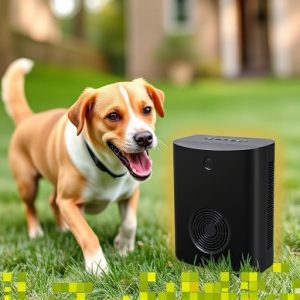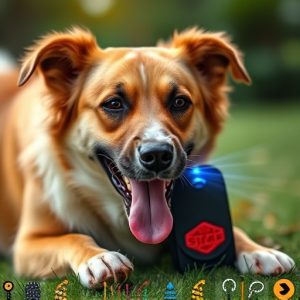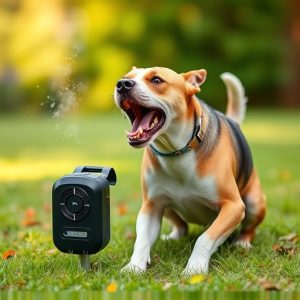Dog Repellent Devices: Effective Use & Safety Considerations with Settings
Electronic dog repellent devices use sounds, vibrations, and mild shocks to curb behaviors like bark…….
Electronic dog repellent devices use sounds, vibrations, and mild shocks to curb behaviors like barking, digging, and chewing. Dog Repellent Device Compliance Testing by accredited labs is crucial for ensuring safety, effectiveness, and adherence to international standards. This testing verifies shock intensity, sound pressure, and device reliability, guaranteeing humane behavior modification without harm. Customization options, including sensitivity settings and zone-based deterrents, allow owners to tailor the device to specific environments and behaviors while adhering to local regulations. Compliance testing offers peace of mind, ensuring these devices meet ethical standards and effectively address unwanted pet behaviors responsibly.
“Discover the revolutionary power of electronic pet deterrents, a game-changer in managing canine behavior. This comprehensive guide explores how these devices, through targeted sound and vibration, safely repel dogs from unwanted areas. We delve into the significance of compliance testing for dog repellent devices, ensuring their effectiveness and safety. Learn about key settings, customization options, and real-world applications, offering solutions for a harmonious coexistence with our four-legged friends while prioritizing ethical considerations.”
- Understanding Electronic Pet Deterrent Devices
- The Importance of Compliance Testing for Dog Repellent Devices
- Key Settings and Customization Options
- Effective Use Cases and Applications
- Ensuring Safety and Ethical Considerations
Understanding Electronic Pet Deterrent Devices
Electronic pet deterrent devices, also known as dog repellent devices, are innovative tools designed to keep pets, primarily dogs, away from specific areas or objects. These devices operate by emitting sounds, vibrations, or mild electrical shocks that are unpleasant for dogs, thereby deterring them from unwanted behaviors like barking, digging, or furniture chewing. Understanding how these devices work and their effectiveness is crucial, especially as pet owners seek humane alternatives to traditional, often harsh, training methods.
Compliance testing plays a vital role in ensuring the safety and reliability of electronic pet deterrent devices. Rigorous testing by recognized laboratories ensures that these devices meet specific standards for electrical safety, human safety, and animal welfare. This process involves assessing the intensity and frequency of shock levels, sound pressure levels, and overall device performance under various conditions. By adhering to strict guidelines, manufacturers can provide peace of mind to consumers, guaranteeing their pets will not be subjected to excessive or harmful stimuli while also effectively modifying unwanted behaviors.
The Importance of Compliance Testing for Dog Repellent Devices
In the realm of electronic pet deterrents, particularly dog repellent devices, compliance testing plays a pivotal role in ensuring safety and effectiveness. This rigorous process verifies that such devices meet established standards for electromagnetic radiation emissions, safety features, and performance criteria. By undergoing Dog Repellent Device Compliance Testing, manufacturers can guarantee that their products not only deter dogs effectively but also pose no harmful effects on the animals or humans. It’s a crucial step to maintain quality, reliability, and ethical production practices in this industry.
Compliance testing involves comprehensive assessments of various aspects, including radio frequency (RF) output power, shielding effectiveness, and potential health risks associated with prolonged exposure. These tests are designed to protect both users and their pets, ensuring that the devices operate within safe parameters. In today’s digital era, where technology is rapidly advancing, regular compliance checks help keep up with evolving standards, enabling manufacturers to deliver innovative yet responsible solutions for pet ownership challenges.
Key Settings and Customization Options
The effectiveness of an electronic pet deterrent device greatly depends on its key settings and customization options. One of the primary settings is sensitivity, which determines how quickly and strongly the device reacts to movement or barking. Users can adjust this based on their environment and the behavior they aim to deter, ensuring it’s not too sensitive that it triggers unnecessarily or too lax for pets to bypass. Another crucial setting is frequency range, which allows for tailoring the signal intensity to different pet sizes and behaviors.
Customization options include programming specific trigger times, setting distinct zones for different levels of deterrent response, and incorporating remote controls or apps for hands-free operation. These features are essential for ensuring compliance with local regulations regarding dog repellent devices, as they allow for precise use and reduce unintended activation. Moreover, many models offer memory settings to store personalized preferences, making it convenient to switch between environments or situations during Compliance Testing.
Effective Use Cases and Applications
Electronic pet deterrent devices have found their place in various applications, proving highly effective in specific use cases. One of the most common and successful implementations is as a dog repellent device. These innovative tools utilize sound, vibration, or a combination of both to discourage unwanted canine behavior, such as barking or trespassing into restricted areas.
Compliance testing for dog repellent devices is essential to ensure their safety and effectiveness. Rigorous assessments verify that these devices meet specific standards, guaranteeing user safety and the desired level of deterrence. By undergoing compliance testing, manufacturers can provide peace of mind to consumers, ensuring their products are not only reliable but also adhere to legal requirements, particularly when considering the potential impact on pets and human neighbors.
Ensuring Safety and Ethical Considerations
Ensuring Safety and Ethical Considerations
When developing electronic pet deterrents, safety is paramount. These devices should be designed to minimize potential harm to both pets and humans while effectively addressing unwanted behaviors. Rigorous compliance testing, adhering to industry standards and regulations, is essential to guarantee their safe operation. For instance, Dog Repellent Devices often employ ultrasonic sounds or mild electric shocks, requiring thorough testing to ensure these stimuli are within safe limits for animals without causing lasting harm or discomfort.
Ethical considerations also play a significant role. It’s crucial to balance the need for pet training and behavior modification with animal welfare. Developers must avoid creating devices that could cause excessive stress or pain, ensuring instead that the deterrents promote positive reinforcement and humane training methods. Ethical practices involve transparent communication about the device’s functionality and potential side effects, empowering pet owners to make informed decisions while promoting responsible pet care.
Electronic pet deterrents, with their adjustable settings, offer a humane and effective solution for managing unwanted pet behavior. By understanding the device’s capabilities through compliance testing, users can tailor the settings to specific needs, ensuring safe and ethical use. This technology not only addresses training challenges but also promotes harmony between pets and their owners, making it an ideal choice for responsible pet care in various applications. Moreover, ongoing research and development promise even more sophisticated features, enhancing the overall effectiveness of dog repellent devices.


